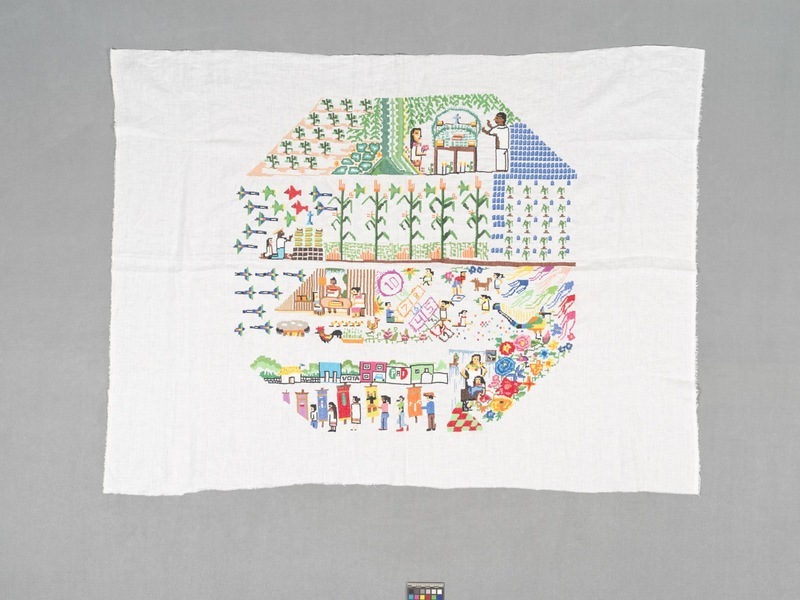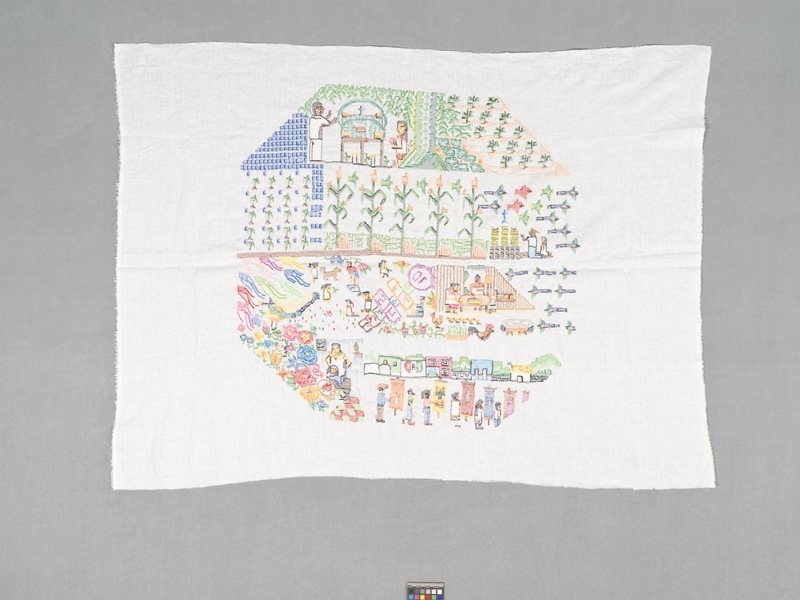Abala Story Cloth Item Number: 3289/58 from the MOA: University of British Columbia


Description
Textile showing a narrative built using coloured hand-embroidered cross-stitching on a metre-squared piece of white linen. The embroidery is confined to a hexagon shape at the centre of the fabric. The narrative works around the cloth, beginning with a depiction of the sowing of maize in a Yucatecan milpa (maize field) when Veronica (the maker) is a child. The milpa is shown, as is Veronica with her grandfather. They kneel before an altar upon which 9 maize kernels are placed. The later scenes show the embroiderer in her house eating with her family, they show her learning to embroider with machine. The connecting images are of birds and floral patterns typically used for traditional dress (the textiles Veronica’s mother is teaching her to make). The final scene shows a religious procession in Abala. In the background are adverts on the walls of Abala, showing the emblem of the PRI (Partido Revolucionario Institucional).
History Of Use
This piece is a continuation of a heritage project initiated by the anthropologist Silvia Teran, in collaboration with the Gran Museo Maya de Merida and the INAH. The project seeks to record elements of Intangible Cultural Heritage, oral narratives, festivities, culturally specific religious practices, and knowledge systems through material heritage production styles that are also eligible for safeguarding.
Iconographic Meaning
The toj bird which is prevalent in Yucatan, has metaphysical meaning and from which David Canul takes his artist name. The cloth narrative focuses on Veronica Cocom learning to embroider by machine as a child. It evidences her desire to learn traditional stitching techniques in spite of her early education. The final panel of the story shows political features of contemporary Abala. The milpa scene not only shows the importance of maize cultivation in this and other parts of Mesoamerica, it also shows the religious and cultural aspects importance of this ancestral knowledge system.
Narrative
Contemporary Maya societies are generally represented by ethnographic collections, many of which focus on material culture traditions, largely the weaving of textiles in Guatemala and Chia-pas. These textiles illustrate contemporary Maya social, cultural and political realities, and they are also frequently associated in Maya literature with archaeological material, in order to evidence long-term cultural continuity. With the intention of showing how Maya epistemologies and contemporary art can be more successfully inserted into museum collections, this acquisition explores the textile traditions of Yucatan which has, in recent years, seen a revival of traditional embroidery. Ethnographic research has shown that people in Yucatecan rural communities, cultural specialists and otherwise, hold philosophies relating to materiality and personhood that can be valuably associated with ancient Maya “artistic” material culture. The inclusion of these perspectives would contribute to the necessary re-positioning of the interpretation and curation of Maya archaeological material. This textile piece is important in considering the relationship between material and intangible heritage.
Item History
- Made by David Canul (Maker) and Veronica del Rosario Cocom (Maker) in Abala, Yucatan, Mexico during 2018
- Collected by Laura Osorio between 2017 and 2018
- Owned by Laura Osorio before April 11, 2018
- Received from Laura Osorio (Seller), Museum of Anthropology Exhibitions Budget (Funding source) and Michael O'Brian Family Foundation (Funding source) on April 11, 2018
What
- Name
- Abala Story Cloth
- Identification Number
- 3289/58
- Type of Item
- cloth
- Material
- linen fibre and cotton fibre
- Overall
- height 99.5 cm, width 135.5 cm
Who
- Culture
- Mexican
- Creator
- David Canul (Maker) and Veronica del Rosario Cocom (Maker)
- Field Collector
- Laura Osorio
- Previous Owner
- Laura Osorio
- Received from
- Laura Osorio (Seller), Museum of Anthropology Exhibitions Budget (Funding source) and Michael O'Brian Family Foundation (Funding source)
Where
- Holding Institution
- MOA: University of British Columbia
- Made in
- Abala, Yucatan, Mexico
When
- Creation Date
- during 2018
- Collection Date
- between 2017 and 2018
- Ownership Date
- before April 11, 2018
- Acquisition Date
- on April 11, 2018
Other
- Item Classes
- textiles
- Condition
- good
- Accession Number
- 3289/0058